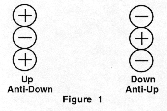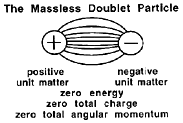
The Four Steps of Deduction
THE NATURE OF MATTER
SUMMARY OF
THE 4 STEPS
OF DEDUCTION
OF DEDUCING THE BACKGROUND OF MATTER
There were four steps of deduction followed in deducing the existence of the a
universal background of matter.

Summaries on this page:
STEP 1 Quark Triplet Substructure
STEP 2 Neutrino Doublet Substructure
STEP 3 Massless Doublet Substructure Particles
STEP 4 Evidence of A Background of Massless Doublet Particles
STEP 1 QUARK TRIPLET SUBSTRUCTURE
Full STEP 1 Explanation
Quark Triplet Substructure
The first step of deduction involved solving the illogic of quarks being fundamental
particles, and yet quarks having fractional electrical charge. Fractional charge
on a fundamental particle is illogical. Fractions indicate division, not something
fundamental in nature. Fractions are ratios of whole units.
The initial hypothesis was that since the fractional electrical charge
of up and down quarks was experimentally verified, and since the fundamental nature
of quarks was not experimentally proven, it had to be the fundamental nature of quarks
that was suspect. A structureless fundamental nature of quarks was especially suspect
since the fractional charge math of quarks could be easily be explained by up and
down quarks having a triplet unit particle of matter substructure consisting of a
group of three unit electrical charge, unit particles of matter.

Two triplet substructures of a group of three unit particles of matter, one for
each up and down quark, explains the fractional electrical charge math of the up
and down quarks as with partial group mathematics of a group of three bound unit
charge particles of matter.
Partial group mathematics is group mathematics of ratios with the numerator counting
one type of the group with the denominator thetotal group. In other words, partial
group mathematics is a ratio of one of the two types of charge to the group as a
whole.
For the normal matter up and down quarks, ratios of the positive charge unit particles
of matter over the group total of three are what are accounted, while for the anti-matter
anti-up and anti-down, the negative charge unit particles of matter are what are
accounted in the numerator which is divided by the group total in the denominator.
|
Normal Matter |
Anti-Matter |
|||
|
Positive Matter |
Negative Matter |
Negative Matter |
Positive Matter |
|
|
up = +2/3 |
up = +1/3 |
anti-up = -2/3 |
anti-up = -1/3 |
|
|
down = -1/3 |
down = -2/3 |
anti-down = +1/3 |
anti-down = +2/3 |
|
Example: Normal Matter Quarks - positive units are tracked in the numerator
Up Quark = two positive units over a group of three with a charge of +1; 2/3 * +1 = +2/3
Down Quark = one positive units over a group of three with a charge of -1; 1/3 * -1= -1/3
The symmetry of the ratio group mathematics also tracks the
charge of the unit particles opposite to the type in the numerator of the ratio.
The right hand columns in both Table 1 and Table 2 are not explicitly
tracked in physics, rather implicitly through the symmetry of the group mathematics.
In fact, the right hand columns in both Table 1 and Table 2 are not
presently known.
Anti-Down
The symmetry of the up and down quark triplets is such that
an up quark is the same entity as the anti-down quark. The partial group charge of
the up quark and the partial group charge of the anti-down quark are different since
for the normal matter up quark, physics employs the positive matter ratio, while
for the anti-matter quark anti-down quark, physics employs the negative matter ratio.
The positive matter ratio of the anti-down quark is seen in Table 1
and Table 2 above to be the same ratio as the positive matter ratio of the
up quark. In fact, they are the very same column, the positive matter ratio column.
STEP 1 FULL EXPLANATION OF FRACTIONAL CHARGE AS GROUP MATH
The quark triplet unit matter substructure offers a physical
mechanism to explain the tripolar
color charge of the strong force and the associated
SU(3) symmetry of the strong force observed in energetic interactions between quarks.
The reason energy exchanged between quarks manifests a tripolor charge and exhibits
SU(3) symmetry is because the structural energy of a quark is divided among three
axes on three units of matter in the quark.
SU(3) is special unitary symmetry with three axes of rotation which equates physically
to a constant amount of energy bound to three interacting axes of rotation on three
units of matter within the quark substructure.
STEP 2 NEUTRINO DOUBLET SUBSTRUCTURE
Full STEP
2 Explanation
Neutrino Doublet Substructure

The triplet substructure of quarks elucidated the difference
between energy and matter as components of particles, which made one wonder if the
unexpected strange traits of neutrinos could be explained with a unit matter substructure.
A neutrino doublet substructure immediately explained two major properties of neutrinos:
Why are there only two types of electron neutrinos?
- there are only two configurations of the doublet, one with the right hand positive unit at the northern end of the common magnetic dipole, and one with the left hand negative unit at the northern end of the common magnetic dipole.
Why does a neutrino exhibit such strange helicity?
- energy only binds to units of matter in a unidirectional fashion depending on the charge of the unit of matter.
The above neutrino traits being explainable via a doublet substructure mechanism was strong evidence to pursue a doublet substructure in further detail.
Why does a neutral neutron have a magnetic dipole?
- the substructure of the neutron is composed of units of matter which have magnetic dipoles.
What is the cause of weak force parity violation?
- caused by the composing units which are made from unit particles of matter and have magnetic dipoles. Neutrino helicity is due to the neutrino doublet substructure.STEP 2 - FULL EXPLANATION OF ABOVE EVIDENCE OF NEUTRINO DOUBLET SUBSTRUCTURE
The weak force exhibits an SU(2) symmetry component because the momentum energy of a neutrino could be on either of two possible units in the doublet substructure.
STEP 3 MASSLESS DOUBLET SUBSTRUCTURE PARTICLES
Full STEP 3 Explanation
The Permanent Nature of Units of Matter
A composite of two oppositely charged unit particles
of matter in a doublet substructure negates the presently held idea that matter is
not of a permanent nature. The immediate consequence of the existence of a neutrino
doublet unit particle substructure is to indicate that matter is not destroyed by
annihilation within the doublet substructure and that there must be a mechanism which
prevents the unit particles of matter from being destroyed within the doublet substructure.
Matter must be permanent in nature.

A neutrino doublet substructure indicates that some force must keep the two unit particles of matter in the doublet from annihilating each other. The conclusion is that unit particles of matter are permanent in nature.
Massless Doublet Particles
Doublet substructures are massless, meaning doublet
substructures have no internal structural energy bound to the particle structure.
Massless, or no rest mass, means there is no internal energy in the particle substructure.
In other words, doublet substructure particles have no rest mass. Doublet substructure
particles are inherently massless.

Neutrinos and photons are massless doublets which have momentum
energy, but no rest mass. The only energy massless doublets have is momentum energy.
Once the doublet substructure of the photon and the neutrino is realized, there is
another possible configuration of the doublet substructure to consider, a doublet
substructure which has no rest mass and no momentum energy.
A configuration of the doublet must be considered which has neither rest mass-energy,
nor momentum energy. If doublets exist, then there could be cold massless doublets
also.
STEP 4 EVIDENCE OF A BACKGROUND OF MATTER
Full STEP
4 Explanation
There are two phenomena in Chapter 4 that are proposed to be evidence of the existence of the background of matter:
- magnetic flux
- the cosmic microwave background radiation
The permanent nature of units of matter indicated by the doublet
substructure require a source for the creation of new particles in energetic interactions.
MAGNETIC FLUX
SECTION
1
Magnetic flux was deduced to be the flow of the background of matter. The invisible
background particles are made visible by the effect of their motion.
COSMIC MICROWAVE BACKGROUND RADIATION
SECTION 2
The cosmic microwave background radiation was deduced to be the thermal radiation
of the background of matter. The background ocean is 2.7 degrees Kelvin.
CONSEQUENCES AND CONSIDERATIONS
The phenomenon known as virtual particle screening was deduced to be caused by energy
hosted by the screened particle energizing background oceanic particles in the proximity
of the host charged energy causing the temporary formation of particles, which then
screen the host charge.
Summary of the Unit Matter Substructure
Chapter 1 The Background of Matter
Chapter 3 The Steps of Deduction
Chapter 4 Evidence of a Background of Matter
PART III PHYSICS MYSTERIES EXPLAINED
Title Page of the Nature of Matter
Table of Contents of the Nature of Matter
Comments welcome: jrees@starlight-publishing.com
Last Update: October 7, 2000
Copyright © 2000
Starlight
Publishing Company
Hermosa Beach, CA
Created May 9, 1997